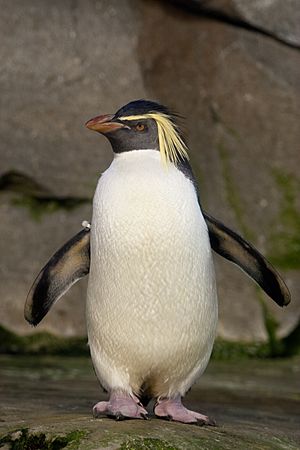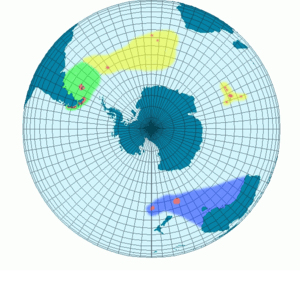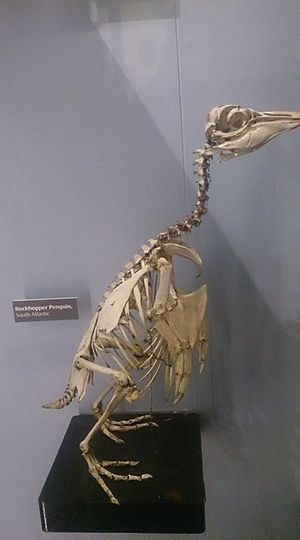Northern rockhopper penguin facts for kids
Quick facts for kids Northern rockhopper penguin |
|
|---|---|
 |
|
| At Berlin Zoological Garden, Germany | |
| Conservation status | |
| Scientific classification | |
| Genus: |
Eudyptes
|
| Species: |
moseleyi
|
 |
|
| Distribution map Moseley's penguin in yellow | |
The northern rockhopper penguin (Eudyptes moseleyi) is a type of penguin. It is also known as Moseley's rockhopper penguin or Moseley's penguin. These penguins live in the southern parts of the Indian and Atlantic Oceans. Scientists have found that it is a different species from the southern rockhopper penguin.
Sadly, a study from 2009 showed that the number of northern rockhopper penguins has dropped by 90% since the 1950s. Because of this big decline, the northern rockhopper penguin is now listed as an endangered species. This means they are at high risk of disappearing forever.
Contents
Understanding Northern Rockhopper Penguins
Scientists have studied rockhopper penguins for a long time. Since 2006, research has shown that northern and southern rockhopper penguins are different. They have different body shapes, sounds, and even different genes. This means they are now considered two separate species.
Scientists believe these two penguin groups became different a long time ago. This happened because of changes in ocean currents and temperatures. Even though they are separate, some northern rockhoppers might travel far from their homes. For example, one penguin found on the Kerguelen Islands might have come from Gough Island, which is 6,000 km away!
Where Northern Rockhopper Penguins Live
Most northern rockhopper penguins, over 99% of them, live and have their babies on Tristan da Cunha and Gough Island. These islands are in the south Atlantic Ocean.
You can also find breeding groups of these penguins on French Southern and Antarctic Lands. These include Amsterdam Island and St Paul Island.
How Northern Rockhopper Penguins Are Different
In 1992, rockhopper penguins were first divided into three groups. These were the southern, eastern, and northern rockhopper penguins. They were identified by small differences in their looks.
These differences include the length of the feathers on their heads. Also, the size and color of the skin around their mouths are different. The patterns on the underside of their flippers also vary. The northern rockhopper penguin is also usually bigger than the other two types.
Scientists also looked at the penguins' genes to see how different they were. They found that the northern rockhopper penguin was more genetically different from the other two. This showed that they were truly distinct groups.
Another interesting way scientists tell them apart is by the tiny parasites that live on them. Each type of rockhopper penguin has its own specific type of chewing louse. These lice cannot easily move from one penguin species to another. This means that if a penguin has a certain louse, it helps scientists know which type of rockhopper it is.
Life Cycle and Reproduction
What Northern Rockhopper Penguins Eat

Northern rockhopper penguins eat a variety of sea creatures. Their main food is krill, which are tiny shrimp-like animals. They also eat other crustaceans, squid, octopus, and fish.
How They Reproduce
Northern rockhopper penguins gather in large colonies to have their young. These colonies can be found right by the sea or high up on cliff sides. Sometimes, they even build their nests a bit inland.
The northern rockhopper penguins living on Amsterdam and Gough islands are separate from those on Crozet and Kerguelen islands. This means they do not breed with each other. They also have different mating rituals. They use different songs and head decorations to attract mates. These differences in behavior and looks show how separate the groups have become.
When they are raising their chicks, adult penguins eat different foods. They eat small zooplankton first, then switch to fish. This shows they are thinking about their future breeding success.
Population and Threats

The number of northern rockhopper penguins has dropped a lot. On Gough Island, there were once millions, but now there are only about 100,000 to 499,999 breeding pairs. On Inaccessible Island, there are about 18,000 to 27,000 pairs. Tristan da Cunha has about 3,200 to 4,500 pairs.
In the Indian Ocean, Amsterdam Island had 25,500 pairs in 1993. St Paul Island had 9,000 pairs in the same year. We don't have recent numbers for these islands. The populations in the Atlantic Ocean are shrinking by about 2.7% each year. This means that on Gough Island, it's like losing 100 birds every day since the 1950s.
Scientists believe several things are causing this decline. Climate change is a big factor, as it changes the ocean environment. Overfishing for squid and octopus by humans also reduces their food supply. Other problems include pollution from boats and tourism. Sometimes, people used to collect their eggs. Also, subantarctic fur seals sometimes compete with them for food or even hunt them.
Tiny goose barnacles can infect the birds, making them sick. House mice have also been brought to the islands by humans. These mice are a problem because they eat penguin eggs and hunt young chicks. To help the penguins, scientists are thinking about ways to manage the mouse population. Climate change also affects how much food is available. This can make penguins less healthy and less successful at having babies.
The northern rockhopper penguin is considered endangered. This is because their numbers have gone down so much over the last 30 years.
Population Trends by Year and Island
| Island | Year | Estimate |
|---|---|---|
| Gough | 1889 | "millions" |
| 1956 | ~2 million | |
| 1979 | 78,300 | |
| 1984 | 142,800 | |
| 2004 | 32,400 | |
| 2006 | 64,700 | |
| Tristan | 1824 | >200,000 |
| 1873 | >200,000 | |
| 1923 | >12,600 | |
| 1955 | 5,000 | |
| 1973 | 7,000 | |
| 1984 | 4,300 | |
| 1992 | 3,343 | |
| 2005 | 3,421 | |
| Inaccessible | 1955 | >25,000 |
| 1989 | 22,000 | |
| 1999 | 27,000 | |
| 2004 | 18,000 | |
| Nightingale | 1973 | 25,000 |
| 2005 | 19,500 | |
| Middle | 1973 | 100,000 |
2011 Oil Spill
On March 16, 2011, a ship called the MS Oliva crashed near Nightingale Island. It spilled many tons of oil into the ocean. The oil slick spread around the island, putting the rockhopper penguins in danger.
Nightingale Island does not have fresh water. So, the penguins were moved to Tristan da Cunha to be cleaned. This helped save many of them from the oil.
Northern Rockhopper Penguins in Pop Culture
Northern rockhopper penguins have appeared in movies and TV shows:
- Cody Maverick, a 17-year-old northern rockhopper penguin, is the main character in the 2007 movie Surf's Up.
- Secret Agent Buck Rockgut, a northern rockhopper penguin, was in three episodes of The Penguins of Madagascar.
- In the Happy Feet and Happy Feet Two movies, a wise penguin named Lovelace is a rockhopper. He gives advice for the price of rocks. Lovelace is voiced by Robin Williams.
- Rocky, one of the mascots for the Penguin Palooza at the Newport Aquarium in Kentucky, United States, is a northern rockhopper penguin.
Images for kids
See also
 In Spanish: Eudyptes moseleyi para niños
In Spanish: Eudyptes moseleyi para niños



